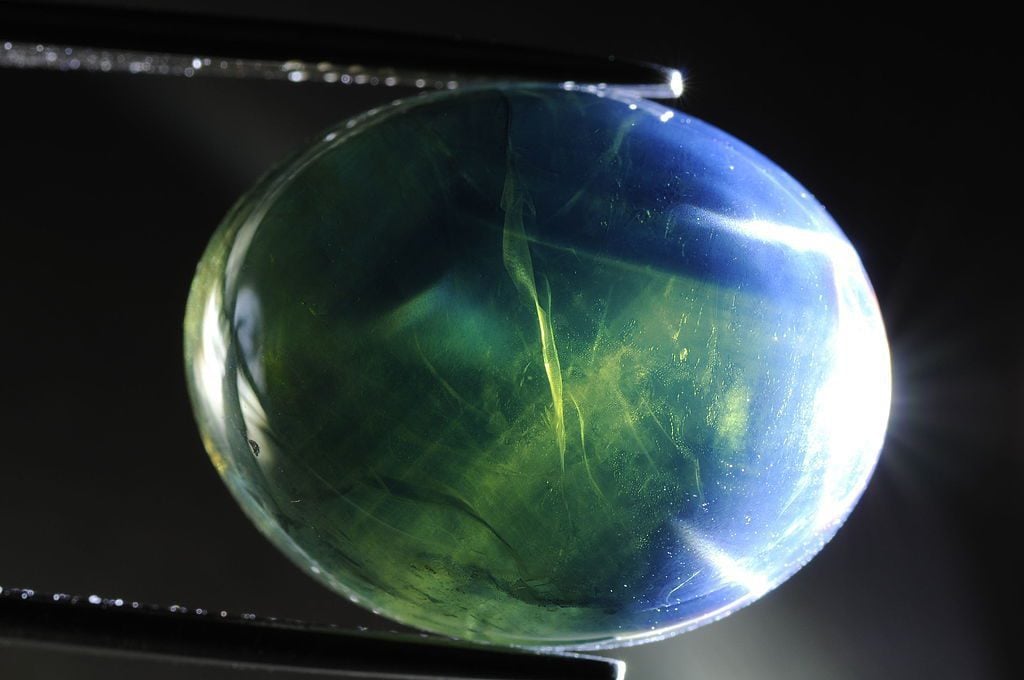Gemstones and Refraction Liquids
Gemologists use refraction liquids to identify gemstone refractive indices (RI). Learn about the properties of these liquids and safe RI testing procedures.
3 Minute Read
Advantages and Disadvantages of Commonly Used Refraction Liquids
Although quite useful, these refraction liquids have some drawbacks. Gemologists, especially novices, should consider their use carefully. These liquids can be expensive, dangerous, poisonous, and/or flammable. However, less aggressive, less expensive dense oil alternatives do exist. For example, glycerol or glycerin oil has an RI of 1.47.
While other dense oils have desirable RIs, many also have very strong scents. Cleaning a gem dipped in these oils can prove difficult. Another problem you might encounter with these alternatives is a lack of purity. When tested with a refractometer, some allegedly pure oils had RIs so low they could only be dilutions. (Editor's note: Some natural oils also simply have variable properties, including RIs). As a rule, anytime you use a new refraction liquid in your lab, check a drop of it in your refractometer to confirm its RI before you immerse your gems in it.
Interested in this topic?
This article is also a part of our Gemology Tools Mini Course, in the unit Measuring Optical Properties.
Let's examine the following table of properties of liquids commonly used to test gemstone RIs.
Table 1: Properties of Commonly Used Refraction Liquids
| NAMES | RI | FORMULA | DANGER | PRICE |
| Carbon Tetrachloride | 1.460 | CCl4 | US$96/liter | |
| Toluene | 1.500 | C7H8 or C6H5CH3 | US$34/liter | |
| Monochlorbenzene | 1.526 | C6H5Cl | US$55/liter | |
| Monobromobenzene, 1-Bromobenzene | 1.560 | C6H5Br | ||
| O-Toluidine, O-Methylaniline, 2-Methylaniline | 1.570 | C7H9N | ||
| Bromoform | 1.590 | Br3CH | US$315/kg | |
| 1-Bromonaphthalene | 1.660 | C10H7Br | US$34/100 ml | |
| Monoiodonaphtalene | 1.705 | C10H7I | ||
| Diiodomethane (Methylene Iodide) | 1.741 | CH2I2 |
Table 2: Hazard Symbol Key
| SYMBOL | HAZARD |
| Dangerous to the Environment | |
| Highly Flammable | |
| Toxic | |
| Harmful |
To learn more about these and other chemical hazards as well as safety precautions, consult this article.
Recommendations
As you can see, we have at least nine products with RIs ranging from 1.460 to 1.741. For a gemological lab, you should have 200 ml of each liquid on hand. Why do you need multiple liquids? You may need refraction liquids with different RIs to see inclusions and determine the RIs of various gemstones.
If you don't want to purchase this many costly and dangerous liquids, you have another option. Look at the details for 1-bromonaphthalene in Table 1. Note that it has a good balance between price and RI. (The color ranges from slightly yellow to deep brownish-yellow). In addition, this product is slightly soluble in water but miscible with alcohol, ether, benzene, and chloroform. Using the purest alcohol you can find, you can dilute 1-bromonaphthalene. Thus, you can create a set of refraction liquids that range from 1.400 to 1.660. To do this, dilute slowly. Take a sample drop of the liquid after each dilution to test in your refractometer. Each time you create a solution with a RI you want to keep, save a batch and label. Then, move on to your next dilution.
Unfortunately, high RI liquids such as monoiodonaphtalene and diiodomethane don't have easy substitutions.
Safety Rules for Refraction Liquids
Safety first! Never forget these important rules:
- Avoid skin contact with the liquids.
- Use goggles and a face mask.
- Keep fresh air in circulation, even by using a small fan if necessary.
- Keep children and animals away from your workspace when using these liquids. (In fact, if you work in a home lab and have children, you probably shouldn't use these liquids at all).
- For each refraction liquid, use one pipette with a paper tag indicating the respective RI liquid.
- Don't mix the tools between liquids or you'll ruin your calibration work.
Partial Immersion Technique
To inspect inclusions in a gemstone, you don't need to immerse it in the refraction liquid completely. Instead, you can use the partial immersion technique.
To do this, place only a drop of liquid over the gem, then observe it.
With this technique, you'll minimize your risk of skin contact and vapor exposure, as well as reduce your use of costly refraction liquids. Figure 1 illustrates the partial immersion technique.
Total Immersion Technique
With total immersion, you can use a mount with a 45° mirror, as shown in Figure 2.
I prefer using an adapted plastic black box, as shown in Figure 3.
Finally, to jog your memory, Figure 4 shows you what gemstones will look like when totally immersed in refraction liquids.
Dr. Raul Berenguel, PhD.
Dr. Raul Berenguel holds degrees in History (Scientific Branch, 2008) and Contemporary Art (PhD, 2012) from the Universidade Aberta. He has specific expertise in the fields of history, gemology, and contemporary art. In addition, he’s also an expert in applying traditional gemological techniques to investigating art objects made from gem materials.
Related Articles
Zircon Sources
Gemstone Radiation Treatment
Ouro Verde Quartz: History and Treatment
Emerald Origins: History and Identification
Latest Articles
Quartz Toxicity: Understanding the Risks for Jewelers and Wearers
Synthetic Amethyst: What is it and How is it Made?
Hambergite Value, Price, and Jewelry Information
Pearl Simulants: How to Spot Faux Pearls
Never Stop Learning
When you join the IGS community, you get trusted diamond & gemstone information when you need it.
Get Gemology Insights
Get started with the International Gem Society’s free guide to gemstone identification. Join our weekly newsletter & get a free copy of the Gem ID Checklist!
